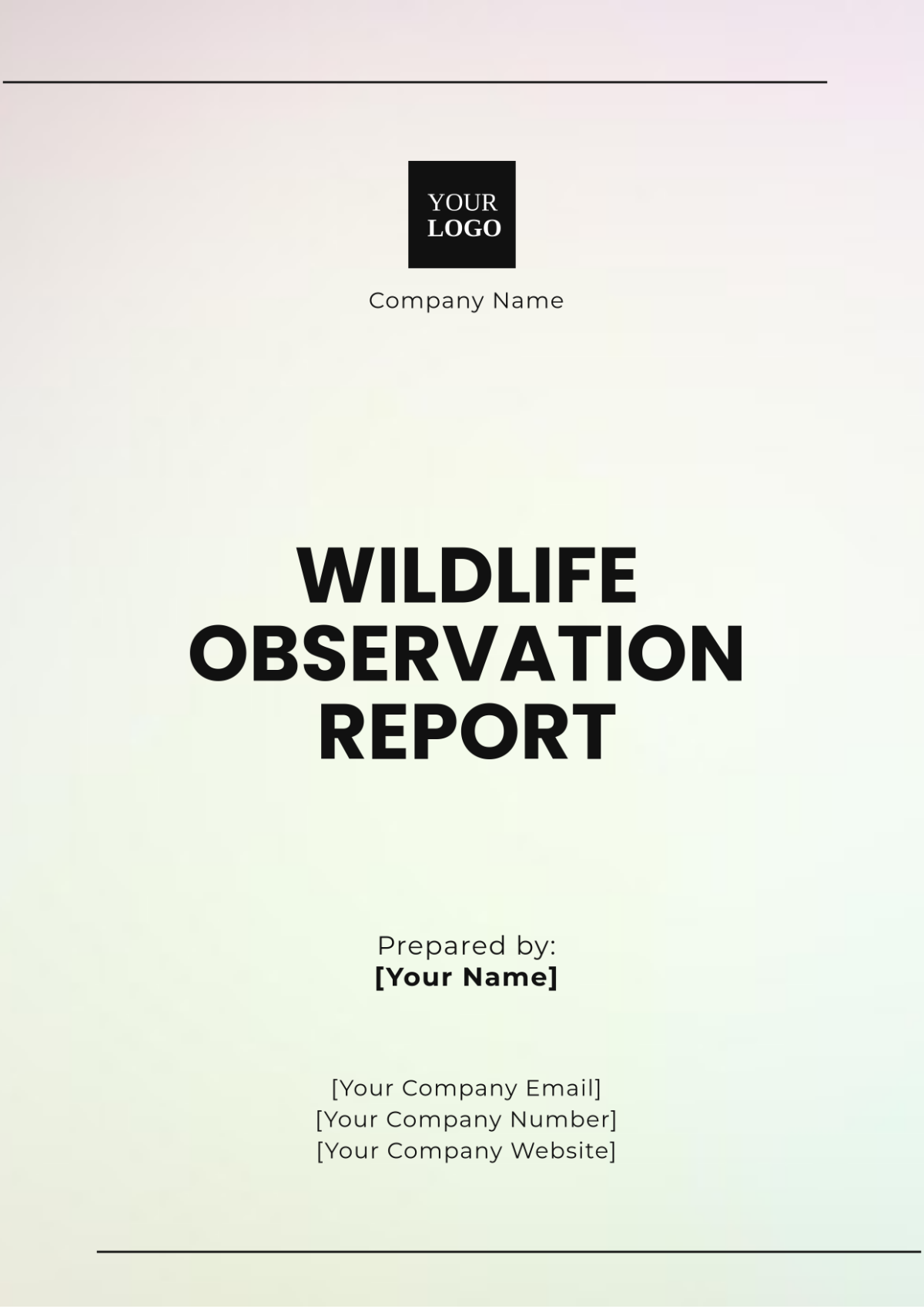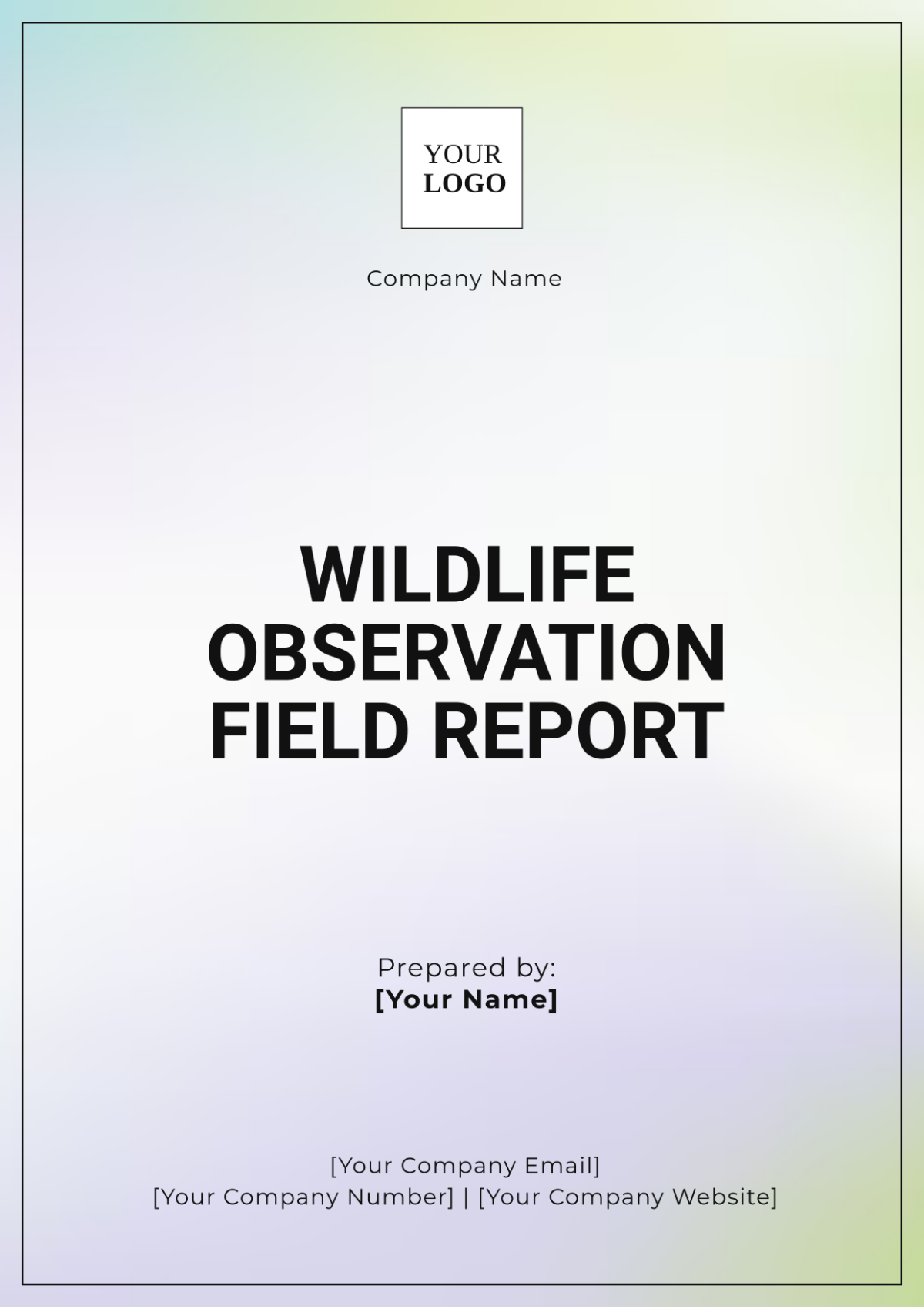Fieldwork Observation Layout Report
Prepared by: [Your Name]
Date: [Date]
I. Introduction
The purpose of this Fieldwork Observation Layout Report is to document and analyze the observations made during recent fieldwork activities in Green Valley National Park. The study aimed to provide a comprehensive overview of the environment, processes, behaviors, and phenomena within the designated area. This report seeks to align the findings with specific research objectives and project goals to derive meaningful insights. The primary focus of this study was to observe ecological interactions, understand the factors affecting biodiversity, and evaluate the potential threats to the park's ecosystems for biodiversity conservation purposes.
The findings presented in this report contribute to the ongoing conservation efforts within the park and provide valuable data to inform future research and management plans.
II. Methodology
A. Study Area
The fieldwork was conducted in Green Valley National Park, located in the southern region of the state, covering an area of approximately 500 square kilometers. The park is home to a diverse range of ecosystems, including dense forests, sprawling grasslands, and aquatic habitats such as streams, ponds, and marshes. The park's ecological significance is highlighted by its role as a sanctuary for several endangered species and its contribution to regional biodiversity.
The decision to conduct fieldwork in this area was based on its rich biodiversity, which includes both native and migratory species. The area has been the focus of conservation efforts for over a decade, with several initiatives aimed at restoring endangered species habitats and controlling invasive species.
B. Data Collection Methods
To ensure comprehensive data collection, a combination of direct observation, surveys, questionnaires, and photographic documentation was employed. Each method was carefully selected to capture the full spectrum of ecological interactions in the park.
Direct Observation: This method involved systematically noting species sightings, behavioral patterns, interactions between species, and environmental conditions. Observations were recorded in real-time, with particular attention paid to predator-prey dynamics, feeding patterns, and seasonal changes in plant and animal behavior.
Surveys and Questionnaires: Surveys were conducted with local wildlife experts, park rangers, and researchers to gather insights on species populations, conservation efforts, and challenges faced by the park. The questionnaires also included questions on local flora and fauna, historical changes in biodiversity, and threats such as illegal hunting and habitat destruction.
Photographic Documentation: Photographs were taken throughout the fieldwork to provide visual evidence of species and environmental conditions. These photographs will be analyzed for further studies and used for educational and outreach purposes.
C. Research Instruments
Several instruments were used during the fieldwork to ensure accurate and reliable data collection:
Instrument | Description |
|---|---|
GPS Device | Used to track locations and create detailed maps of the study area, ensuring the accuracy of species sightings and habitat conditions. |
Camera | Captured high-quality images of flora and fauna, as well as environmental features, allowing for visual analysis and comparison with historical records. |
Binoculars | Facilitated observation of distant species and behaviors, particularly useful in tracking bird species and assessing predator-prey interactions from a distance. |
III. Observations
A. Environmental Conditions
During the fieldwork period, the weather was predominantly mild, with occasional rain showers and a temperature range between 18°C and 26°C. The conditions were ideal for observing most species' daily activities, including feeding, mating, and migration.
Key environmental observations included:
Vegetation: The park's flora was in healthy condition, with dense canopies of oak, pine, and maple trees providing ample shelter for wildlife. The presence of native plant species such as the Blue Orchid was noted, indicating healthy seasonal shifts.
Water Levels: Streams and ponds within the park were slightly higher than usual due to recent rainfall, providing abundant water resources for amphibians and other species dependent on aquatic ecosystems.
Human Activity: Some signs of human disturbance were observed, including footpaths and littering near popular visitor areas, potentially affecting the behavior and health of wildlife populations.
B. Species and Behavioral Patterns
A variety of species were observed throughout the study period. These species were cataloged and categorized based on their behavior, population size, and habitat preferences.
Mammals:
Deer: Deer were frequently seen near forest edges, grazing on grass and shrubs. Their social behavior was observed, particularly during the early morning and late afternoon when they were most active.
Foxes: Foxes were spotted hunting small rodents and scavenging in the forest undergrowth.
Bats: Bats were observed feeding on insects near water bodies, highlighting the park's importance for nocturnal predators.
Birds:
Green Parrot (endangered): A small flock of Green Parrots was observed nesting in the canopy. This species is of particular concern for conservation due to its declining numbers.
Woodpeckers: Several species of woodpeckers were seen feeding on insect larvae and creating nesting holes in trees.
Eagles: A pair of Bald Eagles were seen hunting near the river, showcasing the park's critical role in maintaining raptor populations.
Amphibians:
Frogs and Salamanders: These species were abundant in and around the park’s water bodies, playing a key role in the local food chain by acting as prey for birds and larger mammals.
C. Phenomena
Migratory Patterns: Migratory birds were observed following their usual routes, with several species arriving from the south. This movement coincided with historical data on migratory cycles in the region.
Flowering Patterns: The Blue Orchid and several other wildflowers bloomed earlier than usual, potentially indicating changes in the local climate or shifts in seasonal weather patterns.
IV. Analysis/Findings
A. Alignment with Research Objectives
The observations gathered during this study aligned closely with the research objectives of assessing biodiversity health and understanding the factors that influence species behavior in Green Valley National Park. Key findings include:
The presence of endangered species such as the Green Parrot and the abundance of other native species suggest that conservation efforts are having a positive impact on biodiversity.
Species diversity is a clear indicator of the park’s ecological health. The variety of mammals, birds, and amphibians observed demonstrates that the park is functioning as a robust ecosystem, supporting a wide range of species.
B. Implications for Biodiversity Conservation
The presence of endangered species like the Green Parrot and the observed migratory patterns indicate the need for continued and enhanced conservation efforts. Specific recommendations include:
Enhanced Habitat Protection: Given the park's ecological significance, efforts should be made to reduce human disturbance and prevent further degradation of sensitive areas.
Restoration Programs: Focused habitat restoration initiatives could help support the growth of endangered plant species, improve water quality, and ensure the sustainability of amphibian and bird populations.
V. Conclusion
In conclusion, the fieldwork observations provide a comprehensive understanding of the ecological dynamics within Green Valley National Park. The data collected emphasizes the region's rich biodiversity and the critical need for sustained conservation efforts. Moving forward, these findings will contribute to more targeted conservation strategies aimed at addressing environmental challenges and preserving the park’s biodiversity for future generations.
VI. Appendices
Appendix A: Daily Observation Logs
Detailed logs from each fieldwork day, highlighting key observations, notable species, and any environmental changes encountered.
Appendix B: Species Checklist
An exhaustive list of all species observed during the fieldwork period, including notes on their status (endangered, threatened, or common) and preferred habitats.
Appendix C: Photographic Evidence
A collection of photographs taken during fieldwork, cataloged by location and subject. These images provide visual documentation of species, environmental conditions, and key phenomena observed in the park.





